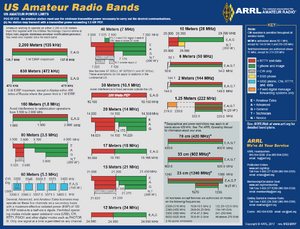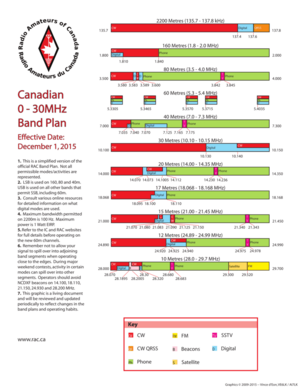Band Plans: Difference between revisions
Tag: Reverted |
Make stub |
||
| (11 intermediate revisions by 4 users not shown) | |||
| Line 1: | Line 1: | ||
A collection of some band plans describing the frequency allocations for each ham band. | A collection of some band plans describing the frequency allocations for each ham band. | ||
==United States | == United States == | ||
[[File:ARRL Band Plan.png|alt=An image created by the ARRL describing the United States amateur radio frequency allocations per band and per class.|thumb|An image created by the ARRL describing the United States amateur radio frequency allocations per band and per class.]] | [[File:ARRL Band Plan.png|alt=An image created by the ARRL describing the United States amateur radio frequency allocations per band and per class.|thumb|right|An image created by the ARRL describing the United States amateur radio frequency allocations per band and per class. [http://www.arrl.org/files/file/Regulatory/Band%20Chart/Band%20Chart%20-%2011X17%20Color.pdf Original document] | ||
]]{{citation needed}} | |||
In the USA, spectrum allocations for non-Federal users are made by the [[wikipedia:Federal Communications Commission|Federal Communications Commission]] (federal agency spectrum use is regulated by the [[wikipedia:National Telecommunications and Information Administration|National Telecommunications and Information Administration]]). | |||
Different classes of amateur radio licensees have different frequency and mode privileges on each band at 10 meters and below. At 70 centimeters and above, all licensees have all frequency and mode privileges. From the 6-meter band to the 1.25-cm band, there are mode restrictions for all licensees (CW-only portions on the 6- and 2-meter bands and a data only portion on the 1.25-m band). | |||
Beyond that, there are generally accepted sub-bands intended for different modes. These are [https://www.arrl.org/band-plan published by the ARRL]. These sub-bands do not have regulatory force, but following them is considered "good amateur practice" and operating in accordance with good amateur practice is required under [https://www.ecfr.gov/current/title-47/chapter-I/subchapter-D/part-97/subpart-B/section-97.101#p-97.101(a) 47 CFR 97.101(a)]. | |||
NTIA's [https://www.ntia.gov/page/united-states-frequency-allocation-chart frequency allocation chart] shows most of the US ham bands in context with many other radio services. | |||
==Canada== | ==Canada== | ||
[[File:Canadian Band Plan.png|alt=An image created by RAC showing Canadian amateur radio frequency allocations below 30 MHz|thumb|right|An image created by RAC showing Canadian amateur radio frequency allocations below 30 MHz [https://www.rac.ca/rac-0-30-mhz-band-plan/ Original Document]]] | |||
Holders of a Canadian Amateur Radio Operator Certificate with the Basic qualification have all band and mode privileges | Holders of a Canadian Amateur Radio Operator Certificate with the Basic qualification have all band and mode privileges on and above the 6-m band. Certificate holders who scored higher than 80% on the Basic exam ("Basic with Honours") also gain all band and mode privileges on and below the 10-m band. Certificate holders can also gain access to those HF bands by obtaining a Morse Code qualification (5 wpm) or by taking and passing the Advanced amateur exam. The Advanced qualification allows higher transmitter power and other non-operating privileges (e.g., trustee of repeater stations and club stations. All exams are conducted by an Accredited Examiner. | ||
The image created by the RAC describing the Canadian amateur radio frequency allocations per band at 10 meters and below. There is no singular offical chart for bands above the 10-m band, instead there are [https://www.rac.ca/operating/bandplans/ charts for each band]. | |||
There is no singular offical chart for bands above | |||
==New Zealand== | ==New Zealand== | ||
The NZART provides a [https://www.nzart.org.nz/assets/info/band-plans/2021-bandplan.pdf very detailed plan] that is not possible to embed here. | The NZART provides a [https://www.nzart.org.nz/assets/info/band-plans/2021-bandplan.pdf very detailed plan] that is not possible to embed here. | ||
==United Kingdom== | |||
The [[Radio Society of Great Britain]] maintains the amateur radio bandplan and updates it every year, it is available to [https://rsgb.org/main/operating/band-plans/ view here on the RSGB website]. | |||
{{Stub}} | |||
Latest revision as of 22:35, 4 March 2024
A collection of some band plans describing the frequency allocations for each ham band.
United States

[citation needed]
In the USA, spectrum allocations for non-Federal users are made by the Federal Communications Commission (federal agency spectrum use is regulated by the National Telecommunications and Information Administration).
Different classes of amateur radio licensees have different frequency and mode privileges on each band at 10 meters and below. At 70 centimeters and above, all licensees have all frequency and mode privileges. From the 6-meter band to the 1.25-cm band, there are mode restrictions for all licensees (CW-only portions on the 6- and 2-meter bands and a data only portion on the 1.25-m band).
Beyond that, there are generally accepted sub-bands intended for different modes. These are published by the ARRL. These sub-bands do not have regulatory force, but following them is considered "good amateur practice" and operating in accordance with good amateur practice is required under 47 CFR 97.101(a).
NTIA's frequency allocation chart shows most of the US ham bands in context with many other radio services.
Canada

Holders of a Canadian Amateur Radio Operator Certificate with the Basic qualification have all band and mode privileges on and above the 6-m band. Certificate holders who scored higher than 80% on the Basic exam ("Basic with Honours") also gain all band and mode privileges on and below the 10-m band. Certificate holders can also gain access to those HF bands by obtaining a Morse Code qualification (5 wpm) or by taking and passing the Advanced amateur exam. The Advanced qualification allows higher transmitter power and other non-operating privileges (e.g., trustee of repeater stations and club stations. All exams are conducted by an Accredited Examiner.
The image created by the RAC describing the Canadian amateur radio frequency allocations per band at 10 meters and below. There is no singular offical chart for bands above the 10-m band, instead there are charts for each band.
New Zealand
The NZART provides a very detailed plan that is not possible to embed here.
United Kingdom
The Radio Society of Great Britain maintains the amateur radio bandplan and updates it every year, it is available to view here on the RSGB website.
| This is a stub. You can help OpenHam Wiki by expanding it. |